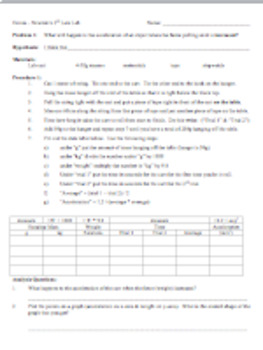Force Bundle
Fudge Factors
66 Followers
Grade Levels
8th - 10th
Subjects
Resource Type
Standards
CCSS8.EE.B.5
CCSS8.EE.C.7
CCSSHSA-REI.B.3
NGSSMS-PS2-2
Formats Included
- Zip
Fudge Factors
66 Followers
Products in this Bundle (7)
showing 1-5 of 7 products
Also included in
- Whatever I have in my other bundles is in this one giant bundle. This way there are no overlaps ("graphing" can overlap with "lab", which can overlap with each of the physics sub-topics of "kinematics", "forces", "momentum and impulse", and "Work-Energy"). Most resources have keys attached.I am in tPrice $68.40Original Price $85.50Save $17.10
- Here are all the physics topics that I have in one bundle:KinematicsForcesMomentum-ImpulseWork-Energy-PowerSome graphing (other graphing is math-focused)Most things have Keys attached.20% discount for bundling.Price $70.80Original Price $88.50Save $17.70
Description
Included are the 7 Force-focused activities & problem sets I use:
1) Intro Elevator Ride Activity
2) Introduction to Free Body Diagrams
3) Basic F=ma problems
4) 2nd law lab ("Low Budget Drag Races")
5) Review of Forces & motion (Kinematics)
6) Two Test versions with keys
7) Buoyancy Lab (3rd Law)
Total Pages
Answer Key
N/A
Teaching Duration
N/A
Last updated Jan 30th, 2020
Report this resource to TPT
Reported resources will be reviewed by our team. Report this resource to let us know if this resource violates TPT’s content guidelines.
Standards
to see state-specific standards (only available in the US).
CCSS8.EE.B.5
Graph proportional relationships, interpreting the unit rate as the slope of the graph. Compare two different proportional relationships represented in different ways. For example, compare a distance-time graph to a distance-time equation to determine which of two moving objects has greater speed.
CCSS8.EE.C.7
Solve linear equations in one variable.
CCSSHSA-REI.B.3
Solve linear equations and inequalities in one variable, including equations with coefficients represented by letters.
NGSSMS-PS2-2
Plan an investigation to provide evidence that the change in an object’s motion depends on the sum of the forces on the object and the mass of the object. Emphasis is on balanced (Newton’s First Law) and unbalanced forces in a system, qualitative comparisons of forces, mass and changes in motion (Newton’s Second Law), frame of reference, and specification of units. Assessment is limited to forces and changes in motion in one-dimension in an inertial reference frame, and to change in one variable at a time. Assessment does not include the use of trigonometry.







